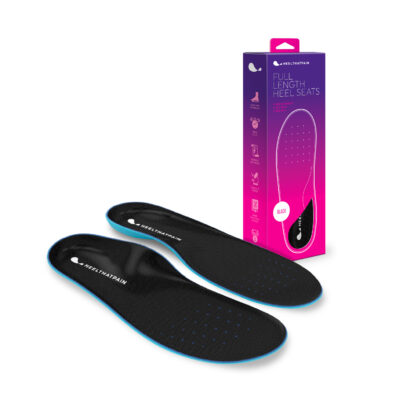Ultrasound for Heel Pain
Ultrasound therapy is a relatively new treatment that has gained a great deal of popularity for its low cost, promising results, and minimal downtime. In the not-so-distant past, people who suffered from chronic plantar fasciitis had one option: surgery. And while success rates were (and are!) high, the expense, recovery time, and pain involved in plantar fasciitis surgery made it a difficult choice.
Thanks to medical advancements over the past 20 years, the number of less-invasive medical procedures available for heel pain and plantar fasciitis has skyrocketed. And for people with chronic heel pain that isn’t responding to conservative treatments, these “next level” treatments are a welcome option to try before surgery!
Here’s what you need to know about non-invasive ultrasound treatment!
Ultrasound Therapy for Plantar Fasciitis and Heel Pain
If you’re thinking, “ultrasound therapy, been there done that!” don’t be so quick to stop reading! Older methods of ultrasound therapy used a small handheld wand to direct rapid soundwaves over surface of the foot. Unfortunately, results were mixed and the treatment fell out of favor with most podiatrists.
The new and promising modern ultrasound therapy on the other hand, uses a hollow tip needle that’s inserted into the skin of the heel. Once inserted, the hollow tip emits high frequency/low amplitude sound waves that break up scar tissue, improve blood flow, encourage a healing response from the body, and reduce inflammation in painful feet and heels. The procedure is easy, quick (one to two minutes), and minimally painful with local anesthetic.
Is Ultrasound Treatment Effective for Plantar Fasciitis?
Several studies point to ultrasound therapy as one of the most effective non-surgical medical procedures for plantar fasciitis. A review of 107 treatment cases with a two-year minimum followup time showed that heel pain improved in 92.5% patients, with only 7.4% of people not experiencing a reduction in their pain (Iborra et. al., 2021).
In a presentation at the Society of Interventional Radiology, radiologist Rahul Razan, stated, “While the long-term outcome studies are in progress, the results we have seen to date are very promising.”
Keep in mind that despite these promising studies, ultrasound therapy may not be right for everyone, especially individuals who have recently been diagnosed with plantar fasciitis. Before you decide to undergo ultrasound therapy, take some time to familiarize yourself with information about who is a good candidate for ultrasound therapy, as well as pros and cons.
Who Is a Good Candidate for Ultrasound Treatment?
Before you decide to undergo ultrasound therapy, most podiatrists recommend trying a dedicated course of more conservative, inexpensive treatment methods.
Surprisingly, around 90% of plantar fasciitis cases can be resolved with proven conservative treatments like stretching, wearing the right orthotics, rest, and icing. While healing may take a few weeks to a few months, diligently using these conservative treatments can be extremely effective for most people.
However, if you’ve been fighting plantar fasciitis pain for a long time, and easy remedies like stretching and orthotic inserts haven’t been effective, you may be an excellent candidate for ultrasound therapy.
Pros and Potential Benefits of Ultrasound Therapy
There are many potential benefits from using ultrasound therapy to treat heel pain. Most importantly, the targeted sound waves emitted from the hollow needle breaks up painful adhesions and scar tissue on the plantar fascia and heel. Much of this scar tissue can then be removed through the needle’s hollow tip, allowing the body to regenerate healthy tissue.
This type of ultrasound therapy is quick (about 90 seconds on average), does not require sedation, shows no major potential complications, and is relatively inexpensive compared to surgery (costs vary greatly depending on your insurance, but may cost as little as a copay).
The targeted sound waves from ultrasound therapy helps increase blood flow and circulation to the injured area, supplying the tissue with additional oxygen and nutrients, removing waste from the tissue, and improving swelling and inflammation.
In the study performed by Advanced Medical Imaging in Lincoln, Nebraska with 65 ‘problem’ plantar fasciitis patients, the the vast majority of participants improved their pain by 90% after two weeks, and maintained those results at the 6-month study follow-up visit (the study was done between 2013 and 2014, but reported out in 2015).
In a nutshell, the pros and benefits of ultrasound therapy for plantar fasciitis include:
- Effective in breaking up and removing scar tissue
- Promising initial study results
- Quick (90 seconds)
- No sedation required, and minimally painful
- Results appear to last
- Affordable as compared to surgery
Cons and Potential Risks of Ultrasound Treatment
While ultrasound therapy shows a great deal of promise, it’s not without its drawbacks.
First and foremost, ultrasound therapy isn’t a miracle cure. If lifestyle factors like poor footwear choices, flat feet, or overuse and deterioration don’t change, plantar fasciitis and heel pain will almost certainly return. If you do decide to undergo ultrasound therapy, make sure to do so in tandem with proven treatments that address the source of plantar fasciitis, like proper supportive footwear, orthotic inserts with Fascia-Bar Technology, rest, and stretching.
There are other potential concerns, too:
- Potentially invasive: While the idea of a ‘hollow needle tip’ might not bother everyone, it can be a big hurdle for people with a fear of needles
- Costly without insurance: While many insurance providers cover ultrasound therapy, some providers and plans do not, and many people do not choose to insure. Out of pocket costs, in these cases, can be more significant.
In general, the benefits of ultrasound therapy tend to outweigh the risks for individuals with chronic plantar fasciitis who aren’t quite ready to consider surgery. It can be helpful to talk to your doctor, who knows your unique medical history, about any additional questions you may have.






